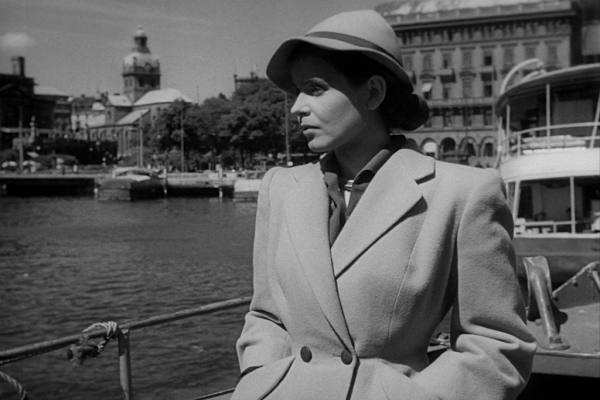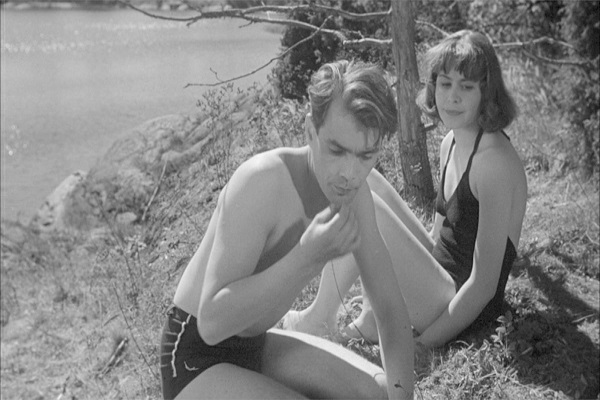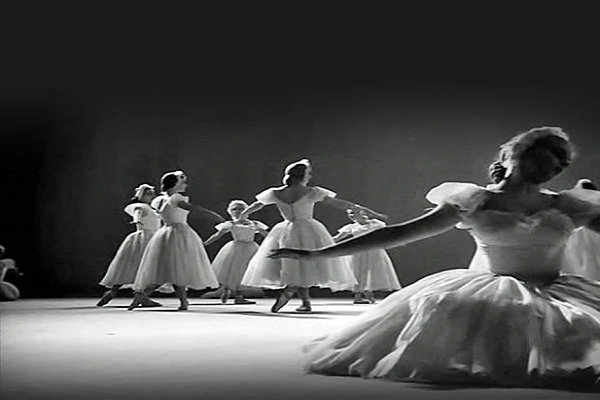Ingmar Bergman’s Summer Interlude is one of the most beautiful films ever. Even though it appears as a melodrama, Bergman found his independent voice as a filmmaker for the first time with this film. He made other famous films with his brain but Summer Interlude with his heart. A prima ballerina’s past romance that ended thirteen years back with her boyfriend’s death is the film’s focus and is shown in flashbacks. Even though she could create a shield around herself, it crumbles when the diary of her former lover is delivered to her one day. Her present life suddenly takes a U-turn. She visits the island and cherishes the sweetest memories of her short-lived love life in the beautiful Swedish summer. In the end, she returns to her current lover. Some moments create such a deep impact on our lives that we never really forget them and keep cherishing them for the rest of our lives.
Even though the Swedish title of the film is Sommarlek which means Summer Play, the English title is Summer Interlude. Summer Play refers to an ordinary incident or drama that might have taken place in one summer. It does not make the story special or hint at a deeper meaning. However, Summer Interlude refers to a more specific summer break that might be the intermission period of some special event. In the film, the summer interlude refers to the period when the protagonist of the film Marie (Maj Britt-Nilsson) had the sweetest days of her teenage romance. So, the English title is more appropriate and meaningful.

In Nordic countries, summer lasts merely two months – June and July. When summers finally arrive after long, chilling, and terrifying winters, citizens welcome them wholeheartedly. They relieve themselves by visiting the countryside. The plethora of natural beauty soothes their heart and soul. In Summer Interlude, a teenage ballet dancer Marie visited her aunt’s house thirteen years back and fell in love with a shy, nerdish, and innocent college student (Birger Malmsten). Their romance grew madly as they spent more time together walking on the beach, bumping into each other, taking shelter in each other’s arms, smiling, laughing, and enjoying to the fullest. They had the first kiss in their lives. Their boundless love knew no bounds. However, as destiny would have it, the happy days didn’t last long. Just three days before their scheduled departure from the island, Marie’s lover Henrik met with an accident when his jump into the sea terribly went wrong. He passed away leaving Marie heartbroken.
The past, present, and future are all important in human life. They exist one after another like a chain. One period can not exist independently without the other two. The past paves the way for the present, and the present builds the base for the future. No matter how far we have traveled, some past experiences always beckon us. Golden memories of life can never be erased. They carve indelible marks in our lives. In Summer Interlude, Marie has forgotten her past and has been living comfortably with dance and her current lover David. However, when the diary of her first lover is sent to her during the dress rehearsal before the performance of the ballet Swan Lake, she returns to the place of her teenage romance and cherishes those golden moments spent with her first lover Henrik. Even though she continues living with David and life goes on, her brief-lived romance with Henrik will always have a special place in her heart.
Summer Interlude is deeply inspired by the brief but intense love affair Bergman had with a girl named Babs in the summer when he was sixteen years old. The Bergman family lived on Orno Island during Ingmar Bergman’s teenage years. He would be stuck with extra studies during his summer vacations and could only occasionally participate in activities with people of his age. He was skinny, had acne, would dress badly, and stammered during conversations. He would read Nietzsche every day. A lonely girl Babs used to live at the far end of Paradise Island. A timid love grew between Ingmar and Babs. Their love story ended at the end of Summer and Babs contacted Polio later. Bergman wrote a short story about this incident. It served as the base of Summer Interlude. In the film, Marie also fell in love with Henrik in one summer during her teenage years, and her love story also ended that summer.

Summer Interlude is the crucial juncture of Bergman’s filmmaking life. Before he made it, his films would feature male protagonists. But his focus shifted to female protagonists from Summer Interlude. He started delving more into the female psyche and continued it for the rest of his life. In Persona, he shows the merge of two female identities. In Cries and Whispers, he depicts the torment, struggle, and relationships of three sisters and a maidservant. In Autumn Sonata, he portrays the pain of a neglected daughter of a renowned pianist. There are multiple other examples. The pain, love, suffering, struggle, sympathy, and redemption of women immensely inspired Bergman’s repertoire from Summer Interlude.
Ingmar Bergman beautifully portrays Marie’s character in Summer Interlude. Viewers can sense the heart-felt love between Marie and Henrik. However, one question remains – why did Marie fall in love with the old uncle? Why did she allow her uncle’s advances? Her uncle might be rich or sophisticated, but, it can not be the driving factor for falling in love despite such a huge age gap. Even though she regrets her decision, it is too late now. Her uncle detached her from the cherished memories with Henrik. While being alive, her relationship with her uncle tormented Henrik and made him insecure. There is only suffering now without any opportunity to mend her mistakes.
Multiple references in Summer Interlude connect to Bergman’s later films. Marie and Henrik collect and eat wild strawberries. Bergman made Wild Strawberries as a feature film later in 1957. After losing Henrik and her probable future with him, Marie questions God’s existence and no longer believes in God. Rather, she hates God. Silence of God became the main theme later for three Bergman films – Through a Glass Darkly, Winter Light, and The Silence. Just before Henrik’s tragic demise, Marie visited Henrik’s house where his cancer-affected aunt was playing chess with a reverend. The reverend told Henrik that he was playing chess with none but death. Playing chess with death is the most important and famous imagery of Bergman’s later film The Seventh Seal. Ideas, themes, and contemplations of artists are reflected in their works. The same happened to Bergman and his films.

Summer Interlude contains the quintessential elements of a Bergman film like love, loss, regret, suffering, reconciliation, and redemption. Bergman shows multiple ups and downs in human life through this film. It is one of the most tragic love stories ever portrayed on the silver screen. Even though it looks like a melodrama, it carries enormous importance in Bergman’s filmmaking career. This is the first film he made with independent contemplation. He said, “For me, Summer Interlude is one of my most important films. Even though it may seem terribly passé to an outsider, for me it isn’t. This was my first film in which I felt I was functioning independently, with a style of my own, making a film all my own, with a particular appearance of its own, which no one could ape. It was like no other film.” The most important aspect of Summer Interlude is Maj-Britt Nilsson’s acting. She portrays two contrasting sides of the same character so brilliantly that viewers get confused about whether the same actor plays earlier and later versions of Marie. While portraying Marie as a jubilant teenage lover, Maj-Britt Nilsson is vivacious, but heartbroken and pensive in Marie’s later years. She is the heart and soul of this film. Even though Bergman did not have much interest in Henrik’s character and referred to him as a mere coat hanger, Birger Malmsten brilliantly portrays Henrik as a nerdish and timid student but a heartful and serious lover. The intense love of Marie for Henrik is largely because of Henrik’s personality and seriousness in the affair. Malmsten meticulously portrays Henrik’s insecurity which is largely inspired by Bergman’s own insecurity. As a sophisticated elite and smitten lover, Georg Funkwist justifies the character of Marie’s uncle Erland. He depicts the typical elite opportunist personality of society in the film. The ballet dancers shown in Summer Interlude were from the Royal Swedish Ballet. Their outstanding performances enrich the film to a great extent.
Like Bergman’s other earlier films, before Sven Nykvist became an integral part of his filmography, Summer Interlude marks the magnificent black-and-white cinematography by Gunnar Fischer. Bright lighting and sharp images make each frame look like a black-and-white portrait. He captured the beautiful ballet dance sequences from multiple angles incredibly dynamically. Even though Sven Nykvist received more recognition as the cinematographer of Ingmar Bergman’s films, Gunnar Fischer’s cinematography reached the supreme level of excellence and received multiple accolades. Oscar Rosander’s brilliant editing matches Gunnar Fischer’s dynamic cinematography, especially in the ballet dance sequences. Rosander uses slow dissolve repeatedly, which gives the scenes a slow and smooth transition. When Henrik passes away, his face is edited brilliantly surrounded by clouds as if he is in paradise. Erik Nordgren’s orchestral background score heightens the emotions and conveys the tragic romantic mood of the film.
Bergman would shoot his films mostly in a studio setup. However, he shot Summer Interlude largely on location as the story demanded. Filming of Summer Interlude gave him one of his most satisfying filmmaking experiences. He thoroughly enjoyed shooting the film in bright summer and autumnal twilight. It was mostly shot on the island of Dalaro. The heart-touching romantic scenes of Marie and Henrik were shot in Stockholm’s outer archipelago. The then-budding director Jean-Luc Godard was so touched by Summer Interlude that he declared it “The most beautiful film in the world”. He said, “There are five or six films in the history of cinema which one wants to review simply by saying, ‘It is the most beautiful of films’. Because there can be no higher praise”.
